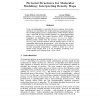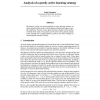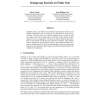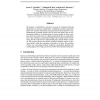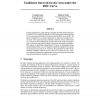NIPS
2004
15 years 2 months ago
2004
X-ray crystallography is currently the most common way protein structures are elucidated. One of the most time-consuming steps in the crystallographic process is interpretation of...
113
click to vote
NIPS
2004
15 years 2 months ago
2004
Various problems in machine learning, databases, and statistics involve pairwise distances among a set of objects. It is often desirable for these distances to satisfy the propert...
105
click to vote
NIPS
2004
15 years 2 months ago
2004
We propose a new interpretation of spiking neurons as Bayesian integrators accumulating evidence over time about events in the external world or the body, and communicating to oth...
101
click to vote
NIPS
2004
15 years 2 months ago
2004
Prediction suffix trees (PST) provide a popular and effective tool for tasks such as compression, classification, and language modeling. In this paper we take a decision theoretic...
103
click to vote
NIPS
2004
15 years 2 months ago
2004
act out the core search problem of active learning schemes, to better understand the extent to which adaptive labeling can improve sample complexity. We give various upper and low...
NIPS
2004
15 years 2 months ago
2004
Complex objects can often be conveniently represented by finite sets of simpler components, such as images by sets of patches or texts by bags of words. We study the class of posi...
106
Voted
NIPS
2004
15 years 2 months ago
2004
In this paper we show that it is possible to model sensory impressions of consumers about beef meat. This is not a straightforward task; the reason is that when we are aiming to i...
96
Voted
NIPS
2004
15 years 2 months ago
2004
We propose a probabilistic, generative account of configural learning phenomena in classical conditioning. Configural learning experiments probe how animals discriminate and gener...
105
click to vote
NIPS
2004
15 years 2 months ago
2004
In many applications, good ranking is a highly desirable performance for a classifier. The criterion commonly used to measure the ranking quality of a classification algorithm is ...
NIPS
2004
15 years 2 months ago
2004
We provide a principle for semi-supervised learning based on optimizing the rate of communicating labels for unlabeled points with side information. The side information is expres...
